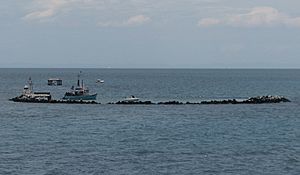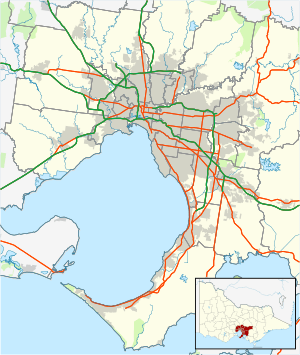Pope's Eye facts for kids
Quick facts for kids Pope's Eye |
|
|---|---|
 |
|
| Location | Port Phillip, Victoria |
| Coordinates | 38°16′37″S 144°41′56″E / 38.277°S 144.699°E |
| Elevation | descends 1.5–10 m (4 ft 11 in – 32 ft 10 in) |
| Area | 4 hectares (9.9 acres) |
| Geology | Man–made bluestone boulders |
| Operator | Parks Victoria |
| Designation | Port Phillip Heads Marine National Park |
| Website | Pope's Eye |
Pope's Eye is a special place in Port Phillip, Victoria, Australia. It was started a long time ago to be a fort, a strong building to protect the entrance to the bay. This fort was never finished.
Pope's Eye covers an area of about 4 hectares (10 acres). It is one of six important spots that make up the Port Phillip Heads Marine National Park. Many people love to visit Pope's Eye for diving and snorkelling.
Contents
What is Pope's Eye?
Pope's Eye has been a protected marine reserve since 1979. It is now part of the Port Phillip Heads Marine National Park. You can find it about 7 kilometers inside Port Phillip Bay. It is 3 kilometers east of Queenscliff. It is also 5 kilometers north of Portsea.
The name "Pope's Eye" comes from a naval midshipman. It has nothing to do with the Pope or religion.
Building the Fort
Work on Pope's Eye began in the 1880s. Sir William Jervois was in charge of the project. Workers dumped many large bluestone rocks into the water. They piled these rocks on a sandbank that was 12 meters deep.
Slowly, the rocks formed a horseshoe-shaped reef. This artificial reef was open to the northeast. It just barely reached above the high-water level.
Why Construction Stopped
Building the fort stopped before it was finished. This happened because naval guns became much better. New guns could protect the entrance to Port Phillip, known as The Rip, from other places.
These powerful guns were placed at Swan Island fort. They were also at Fort Queenscliff and Fort Nepean. Because of these new defenses, Pope's Eye was no longer needed for military purposes. Today, the reef has a navigation beacon to help boats find their way.
Inside the Eye
The middle part of the 'eye' is only about 2 meters deep. Small boats can easily get inside this area. It offers a safe place to anchor, protected from strong currents. The whole structure is very popular with people who enjoy snorkelling and scuba-diving.
Underwater Life at Pope's Eye
The reef at Pope's Eye is a rich home for many creatures. It has an underwater forest of marine algae, like giant and leathery kelp. This plant life helps support many different kinds of fish and marine invertebrates. You can find sponges and colorful soft corals here.
Important Bird Area
Pope's Eye is part of a special place called the Swan Bay and Port Phillip Bay Islands Important Bird Area. This area is recognized by BirdLife International. It is a very important spot for birds.
Pope's Eye is a key breeding ground for Australasian gannets. These birds build their nests on platforms made for them. They also nest on the rocks of the reef. Black-faced cormorants use the rocks for resting. Ruddy turnstones come here to find food.
Marine Mammals
You might also see some amazing marine mammals at Pope's Eye. Australian fur seals often visit the site. Burrunan (bottlenose) dolphins are also frequent visitors to this vibrant underwater world.


